V. R. Poplavko - from heaven to armored car
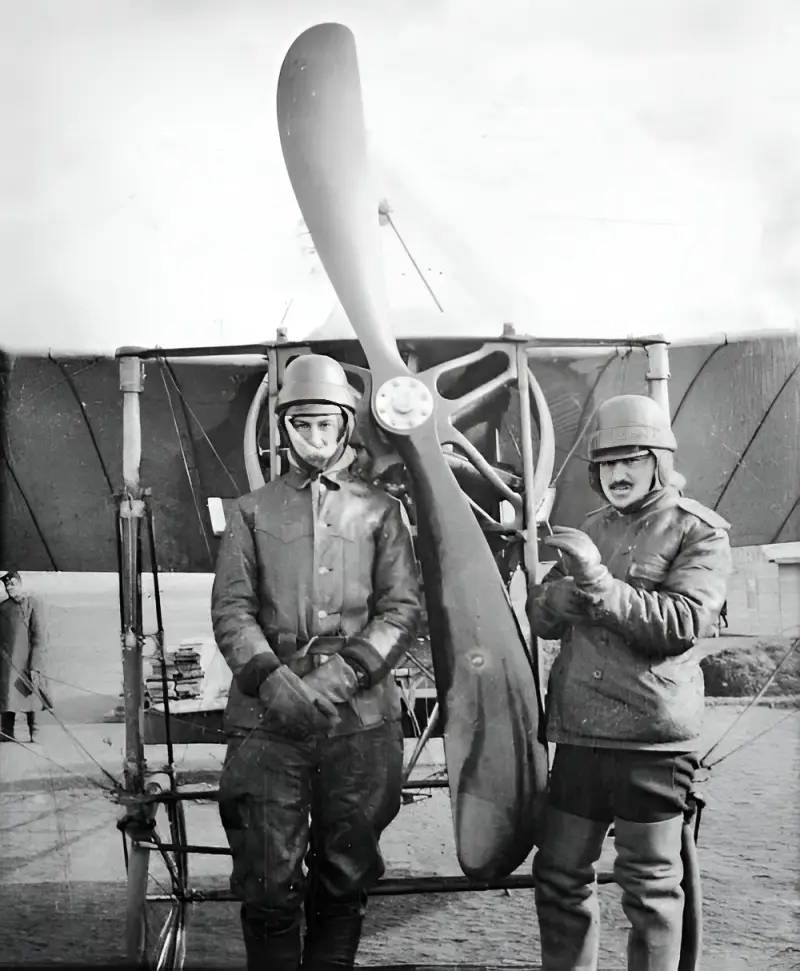
Part I. The history of the creation of the first Russian fighter aircraft
foreword
Initially, this story was intended as a chapter in a small historical study telling about the creation of the first production models of Russian and Soviet wheeled off-road vehicles. But in the process of collecting information about the main character of the first chapter, I was struck by the obvious originality and versatility of his personality. That's why historical justice requires a detailed description of his bright life path.
The task was complicated by the fact that information about the hero’s life is very scarce and sometimes contradictory. This story attempts to connect various data with each other through intuition, and to restore individual gaps using creative imagination. But the framework of the narrative rests on clearly recorded historical events.
The story does not pretend to be a historical work. This is a kind of legend, artistic fiction, a kind of attempt to breathe life into the hero of the story, who has not been seen in this world for a long time...
And how well this attempt succeeded is for you, the reader, to judge.
The birth of a hero and the beginning of his military career
The history of Russia is notable for the fact that the first inventions in domestic aeronautics and automobile construction were made by officers.
The first Russian aircraft with wings and a motor was invented by naval officer A. F. Mozhaisky. The first internal combustion engine for an airship was designed in 1884 by naval officer O. S. Kostovich. The first Russian car was designed in 1896 by naval officer V. A. Yakovlev.
And there was another legendary officer in Russia who made a huge contribution to the development of military equipment - V. R. Poplavko.
In that fabulous era, Russian people were patriots of their Motherland, and serving in the Russian army was considered a matter of honor by many. A strict selection process was carried out at military schools; physically strong, energetic and purposeful young men from the best strata of society ended up there. And the unified system of basic education established in them provided young people with a good store of knowledge necessary in military affairs.
Viktor Rodionovich Poplavko (a nobleman of the Poltava province by birth) was born on November 24, 1880 (old style) in Poltava and in his youth chose the main business of his life to serve in the Russian Imperial Army (RIA).
It should be noted that in those years young men became officers in two ways.
Most often, parents first sent the child to the cadet corps, where he received basic military training and got used to living in a barracks situation in a team isolated from the outside world (exit from the corps territory only on “leave days”). From an early age, teachers instilled in children the best traditions of the Russian Army (including the ability to wear a uniform and be proud of it), gave them a good base of basic school knowledge, and paid special attention to physical training.
Then, if the young man did not have the desire to devote himself to some peaceful profession, he “passed the exam” at the cadet school, from where he graduated as an officer, and was sent to the Russian army for further service.
Junkers jokingly called such freshmen “coming from the swamp.”
Much less often, young men entered the cadet school after graduating from regular school; they were jokingly called “those who arrived from the station.” They had difficulty adjusting to their new environment, consisting of former cadets. Lacking proper physical training and the simplest military skills, and also not accustomed to life in the barracks, they could not “get used to” a specific team in a short time, could not withstand the hardships that fell on their shoulders, and with rare exceptions dropped out of the school in the first months of training.
Young Poplavko already at this initial stage of his military career showed his obvious originality. He arrived at the school neither “from the station” nor “from the swamp”.
Victor, as they said then, “entered service” in February 1899 directly into the troops - into the 36th Oryol Infantry Regiment “as a volunteer II category.” That is, in modern terms, he began his service as a simple soldier who joined the army voluntarily.
In April 1899, the young man completed the training team course, and in June 1900 he received his first military distinction - a badge for excellent target shooting.
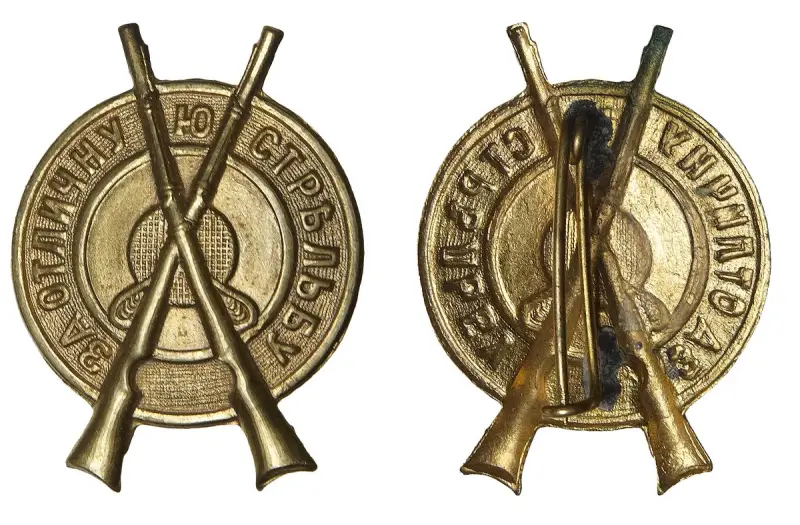
In August 1900, Poplavko was sent to the Chuguev Infantry and Junker School “to take the entrance exam” and in the same month he was included in the list of junior cadets. Then he was already 19 years old, and among his classmates (yesterday’s cadets) he looked like a kind of experienced “army grandfather”.
In November 1901, Victor was transferred to junior non-commissioned officers of the school.
In August 1902, “after completing a course of science at a military school” in the first category, Poplavko was “renamed” to lieutenant officer and transferred to the 74th Stavropol Infantry Regiment, where he arrived in August of the same year.
Since the school was then still a two-year school, its graduates were promoted to officers not at the school, but upon arrival in the troops after some time, but in the year of graduation.
In December 1902, V. R. Poplavko was promoted to his first officer rank of second lieutenant by the Highest Order and transferred to the 76th Kuban Infantry Regiment, where he arrived on December 25, 1902.
He begins his service as a temporary battalion adjutant. In 1904, the young officer temporarily served as head of the hunting team and commander of the 8th company of the same regiment.
In June 1904, Poplavko was seconded for 6 months to the 74th Stavropol Infantry Regiment “for the benefit of the service.”
However, Victor did not have time to benefit the service in full, since already in October 1904 he was transferred to the 9th Ingria Infantry Regiment, and in December of the same year he became a junior officer of a foot hunting team and took part in the Russo-Japanese War.
It is necessary to clarify here that in combat conditions, hunter teams were small units that were mainly engaged in tactical reconnaissance and sabotage in the immediate rear of the enemy.
Apparently, Victor now found himself in conditions that allowed him to demonstrate with the greatest benefit the best qualities of a combat intelligence officer: courage, determination and the ability to think outside the box.
Apparently, Victor fought bravely, therefore, by order of the troops of the 3rd Manchurian Army dated May 12, 1905 No. 42, he was awarded the Order of St. Anne, 4th degree with the inscription “For bravery”:
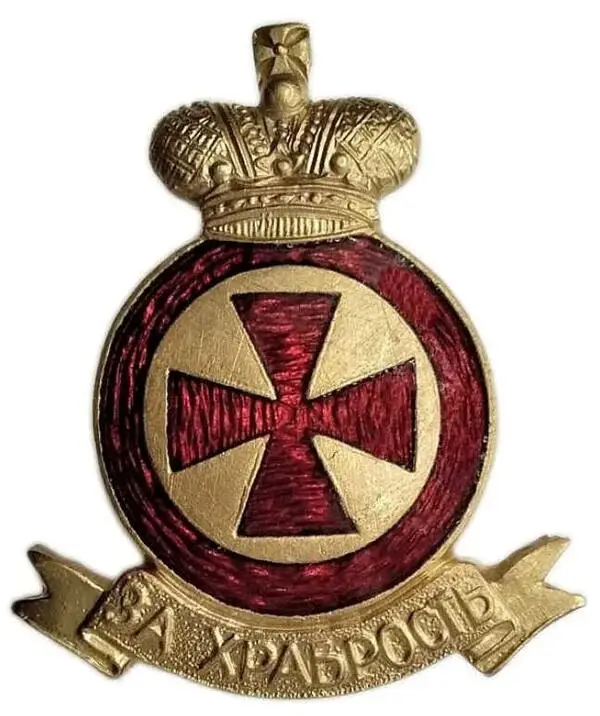
And literally 2 months later, in April of the same year, he received the second order - St. Svyatoslav, 3rd degree with swords and bow:
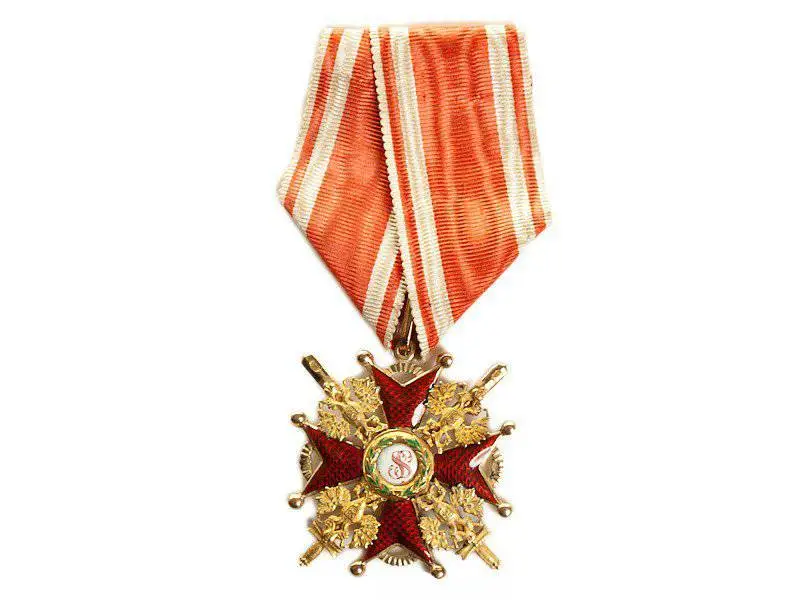
During participation in hostilities in 1904–1905. Poplavko was not wounded or shell-shocked.
In November 1906, V.R. Poplavko was promoted to lieutenant “for his length of service” (in the RIA, length of service in the rank of second lieutenant was 4 years, and the same amount in the rank of lieutenant). On November 24 he turned 26 years old.
After the war, Victor’s career somehow did not work out. Why this happened, one can only guess. I believe that by his nature, like any good military intelligence officer, he was distinguished by excessive dashing, independence and straightforwardness in dealing with his superiors. Which in a combat situation was clearly beneficial to the cause, but in a peaceful situation only aroused the hostility of the authorities. Perhaps that is why his further military career developed somehow too floridly.
In April 1907, for further service, he was sent to the 137th Nezhinsky Infantry Regiment, but for some reason he was again assigned for 6 months. And the regiment was included in the lists of permanent personnel only on September 15, 1907. However, after this he did not have time to serve even six months, and on February 29, 1908 he was suddenly enlisted in the reserve.
But in June 1910, Poplavko returned to military service, now in the 11th Phanagorian Grenadier Regiment. In the same month, he was appointed temporarily acting as regimental quartermaster and at the end of the same year he was confirmed in this completely non-combatant position.
But the following year, 1911, Viktor Rodionovich’s career suddenly took a sharp turn upward, and in the literal sense.
In March of this year, he surrenders his position and is sent... to the city of Sevastopol to the newly established officer school aviation air department fleet, later known as the Kachin Aviation School.
Moreover (which is now difficult to believe) the future military pilot Poplavko had poor eyesight from the time of the cadet school and for this reason wore glasses.
Despite this circumstance (another manifestation of originality), on March 26, 1911, Viktor Rodionovich Poplavko arrives at school, becomes one of the officers of the first intake and already on June 9, 1911 passes the test for the rank of pilot, and on August 6, 1911 he was awarded the rank of pilot- observer.
During training he was in the air for 19 hours and 37 minutes.
Perhaps he had congenital farsightedness, which necessitated the need for glasses only when reading and writing and did not in any way interfere with the control of the airplane.
The newly trained pilot was detached from school on November 16, 1911 and sent to Chita to the 4th Aeronautical Company (April 1912).
On December 15, 1912, Poplavko was promoted to staff captain, in which rank he remained, happily remaining there until the death of the Russian Imperial Army.
In the same year, he received another award - a light bronze medal for the Russo-Japanese War on the Vladimir Ribbon. And in the next - another light bronze medal, now on the Romanov ribbon (in honor of the 300th anniversary of the House of Romanov).
In 1914 (presumably in February) V.R. Poplavko was seconded to the headquarters of the Moscow Military District and was a member of the 4th Aviation Company located in the city of Lida (apparently, he was destined to constantly hang around in the status of a secondee).
The history of the creation of the first Russian fighter
About that period of Viktor Rodionovich’s life, only echoes of heroic deeds have reached us: newspapers wrote about the long flight made by the pilot Viktor Poplavko. They were talking about a terrible plane crash when, due to a breakdown in the air, pilot Poplavko made an emergency landing, and ended up hitting the ground so hard that another pilot, P. A. Samoilo, sitting next to him, had his heels fly off his boots. The airplane was smashed to pieces, but the pilots were not injured - God preserved the pilots for their future exploits.
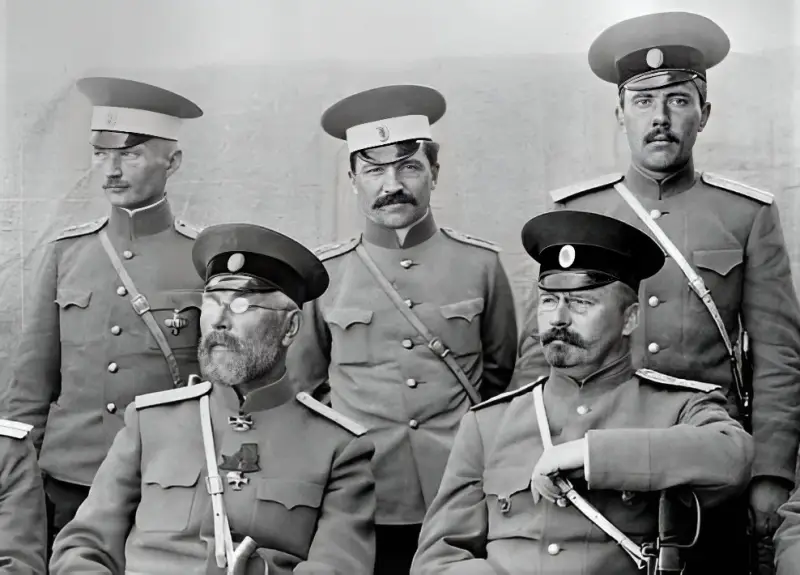
V. R. Poplavko among colleagues (standing in the center)
The general public of Russia first heard the name of our hero in 1913. And, as befits a truly great man, his appearance on the historical stage was extremely stormy and accompanied by loud noise effects.
One fine summer morning, the sweet dreams of young summer residents basking on feather beds in Serebryany Bor near Moscow were interrupted by the loud roar of an aircraft engine, which was at times accompanied by the angry rattling of a machine gun. The cause of the commotion was a small, nimble airplane, performing incredible somersaults in the air over the nearby Khodynskoe field and, as it performed maneuvers, rushing over the very roofs of the dachas hidden under the pine trees. He then quickly soared up, then fell down like a kite and, in a low-level flight, rushed literally a few meters above the ground.
At that time, no one knew that this dashing military pilot Viktor Poplavko was demonstrating to the “highest commission” the new tactics he had developed for using airplanes to destroy enemy personnel.
It is necessary to explain that in those years, at the dawn of aviation, the main task of military airplanes was to conduct aerial reconnaissance: the airplane flew over the line of enemy defense, the observer sitting in front marked the enemy’s fortifications on a layout map, and the pilot behind him controlled the aircraft.
The aviation task also included adjusting artillery fire and bombing. But the latter was concomitant; at that time airplanes could not carry heavy bombs on board.
If a Russian airplane met an enemy airplane in flight, then at best the pilots could arrange an “air duel”, shooting at each other with service revolvers to no avail.
Viktor Rodionovich Poplavko came up with a reasonable idea to expand the combat capabilities of the airplane. He installed a Maxim machine gun on a special turret in front of the observer. Now the observer turned part-time into an air gunner: in the process he could shoot down with a machine gun an enemy airplane that had foolishly found itself on a collision course, or use machine-gun fire to comb through some column of enemy soldiers moving along the road.
After conducting several test flights and testing out his invention, Poplavko decided to clearly demonstrate to the command the operation of his device with a view to its further implementation on Russian military airplanes. The Khodynskoye field near Moscow was chosen for the display.
Victor put the best pilot from his squad behind the controls, and, remembering his dashing infantry youth, he took up the machine gun. After this, the complete end of the world began: the airplane roared over the field, and Victor dashed in short bursts at the targets. Having fired all the ammunition, the airplane came in to land, and after a few minutes there was silence.
After some time, beautiful lacquer carriages with gilded coats of arms began to roll up to the Khodynskoe field one after another. This was a parliamentary delegation from summer residents, consisting of the most beautiful and influential ladies of high society. They were in tears, terribly indignant and demanded that the generals immediately stop “this whole nightmare.” And some seriously frightened noble ladies even threatened to complain to the Tsar himself (!).
Alarmed by such an unexpected turn of events, the inspecting generals immediately sent orderlies to the buffet for fruit and champagne, and they themselves began to gallantly calm the gentle ladies and their tremulous daughters. Little by little, things began to improve: the tears dried up, smiles appeared, and in some wonderful women’s eyes, sly little devils even began to jump.
Soon, a woman’s laughter, so unusual here, began to be heard over the Khodynka field, glasses clinked, fiery speeches sounded (Oh, mon general, you were so brave... madame, allow me your glass... mesdemoiselles, if you please, taste the pineapple, real honey...).
The resulting idyll was ruined by Poplavko. He somehow quietly approached from the side and, hiding a sly smile in his thick mustache, announced that he would convincingly ask the respectable company not to disperse. In a few minutes, the second part of the performance will begin, in which he will show the respected public how, with the help of a fire device he invented, one can shoot down enemy airplanes in the air.
Here the ladies, without saying a word, roared in unison, the senior officers, breathless, began to furiously wave their fists in the air, and the head of the airfield summed it up: “Here, by the way, is an aircraft park, not a cemetery for downed airplanes.”
With this, Poplavko’s flights were successfully completed, but in vain...
But then, none of those present even suspected that a significant historical event was taking place before their eyes - the birth of the first Russian fighter, and this short, mustachioed officer was its creator.
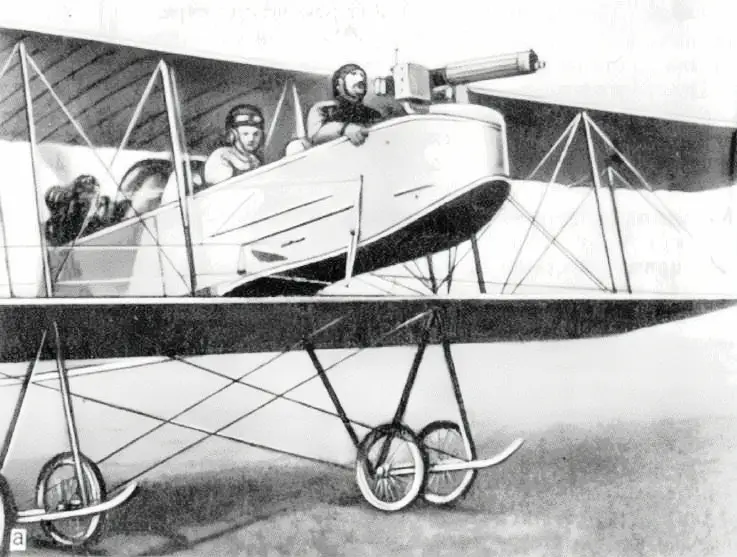
Later, at a friendly officers’ party, Victor’s bosom friend and fellow daredevil Pyotr Nikolaevich Nesterov, with a slight note of envy, will say to the pilots of his squad: “Well done Vitenka! He clearly showed everyone that a machine gun on an airplane is not a superfluous thing. Only here’s the catch - he would also try to shoot back dashingly from my airplane.”
The fact was that the Poplavko airplane of the Farman-15 model had a propeller at the rear, and the gondola in which the crew was located was located at the front, so nothing interfered with the firing. But on the Nieuport, on which Nesterov flew, the propeller was located in front, and not a single sane pilot at that time thought of shooting through the propeller.
Of course, this very funny story is the author’s fiction (may the reader forgive him for this). However, it is reliably known that the RIA military pilot V.R. Poplavko in 1913 repeatedly demonstrated to various commissions at different airfields his airplane, armed with a machine gun. But, surprisingly, such an important invention for Russian military aviation was not used.
However, there was nothing surprising in this. In those years, among the high command of the Russian army there were many German agents, doing their best to slow down all useful innovations. And there were also plenty of simple-minded people among the generals.
As a result, the final conclusion was made: “The use of a machine gun on an airplane is impractical and extremely dangerous, since the strong vibration that occurs during shooting can lead to its destruction and death.”
Victor Poplavko's invention was shelved.
And only in 1916 the first fighter squadrons were formed in the RIA. Therefore, 1916 is considered the year of birth of Russian fighter aviation, although in fact the initiator of this endeavor was Viktor Rodionovich Poplavko back in 1913.

V. R. Poplavko at the airplane propeller (standing on the right)
Information